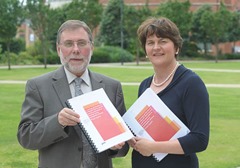Mapping the sector
 A detailed study has outlined the shape of the social economy in Northern Ireland.
A detailed study has outlined the shape of the social economy in Northern Ireland.
The Executive’s ‘third sector mapping’ project has provided a detailed insight into the characteristics of the social economy in Northern Ireland. The report was compiled by PwC and commissioned by the Department of Enterprise, Trade and Investment and the Department for Social Development.
It followed on from a Programme for Government commitment to “baseline” existing social enterprise activity and identify opportunities for growth.
Enterprise Minister Arlene Foster welcomed the report as “further evidence of the continuing growth of the social economy sector.” Social Development Minister Nelson McCausland saw “considerable potential for growth within the voluntary and community sector to move to a more business-focussed social economy model.”
Officials from both departments planned to develop a joint action plan, although this has not yet been published.
Three types of social enterprise were identified, depending on the percentage of income derived from trading:
• embryonic (15-25 per cent);
• emerging (25-50 per cent); and
• established (more than 50 per cent).
The authors surveyed 152 social enterprises. These found that only 2 per cent had annual turnovers of above £10 million with 36 per cent having a turnover of £99,000 or less.
In 2010-2011, 68 per cent reported a profit but the rest did not and this trend was generally the same across established, emerging and embryonic enterprises. Nineteen per cent of the profitable enterprises made a reported profit of £100,000 or over.
Almost half (48 per cent) had less than six employees although a significant minority (13 per cent) employed 26 or more people.
Belfast had the highest concentration of social enterprises (35 per cent) followed by County Antrim (24 per cent). The level of activity was particularly low in County Armagh (5 per cent) and County Fermanagh (3 per cent), although Fermanagh’s figure could be explained by its small population.
Sixty-six per cent of social enterprises were legally registered as companies. Other types of enterprise included charitable incorporated organisations (11 per cent), industrial and provident societies (7 per cent), community interest companies (5 per cent) and unincorporated associations (4 per cent).
A large percentage (77 per cent) planned to expand. Embryonic social enterprises focused on expanding in the next six months while their most established counterparts planned to expand in the next year or two.
Growth strategies included merging with other third sector organisations (to cut costs), developing a five-year business plan and strengthening trading links with Britain and the Republic.
Lack of available finance was the main barrier to growth but a lack of vision within its workforce and a feeling that they were “not trusted by government” were also cited. Small social enterprises often did not bid for public sector contracts as they felt that they could not complete against larger public or private sector organisations.
Government grants only accounted for a small percentage of social enterprise income: 9 per cent although a further 11 per cent came from trading with government. The majority of income (66 per cent) was from non-government trading activity.





